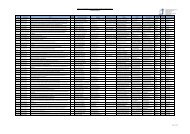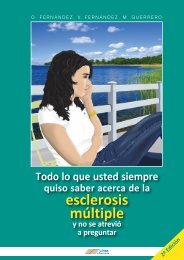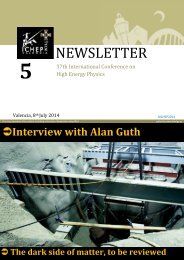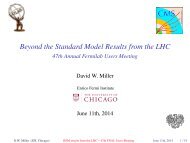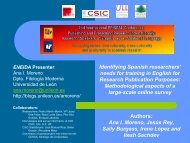PW_mar13_sample_issue
PW_mar13_sample_issue
PW_mar13_sample_issue
Create successful ePaper yourself
Turn your PDF publications into a flip-book with our unique Google optimized e-Paper software.
physicsworld.com<br />
Feedback<br />
Letters to the editor can be sent to Physics World,<br />
Temple Circus, Temple Way, Bristol BS1 6HG, UK,<br />
or to pwld@iop.org. Please include your address and<br />
a telephone number. Letters should be no more than<br />
500 words and may be edited. Comments on articles<br />
from physicsworld.com can be posted on the<br />
website; an edited selection appears here<br />
Physics in India<br />
As a close follower of Physics World and an<br />
aspiring science popularizer, I found your<br />
special report on India quite timely as it<br />
reflects the enhanced efforts to promote<br />
research in this country. However, the<br />
report reflects more of the positive<br />
changes that are happening and ignores<br />
some of the serious problems that India<br />
faces in producing a high-quality talent<br />
pool at the undergraduate level.<br />
There are many pockets of excellence<br />
in India where high-quality research is<br />
conducted. However, these centres of<br />
excellence are not involved in training<br />
undergraduates, and the institutions<br />
that do train undergraduates are not<br />
involved in research. Most Indian students<br />
therefore do not go through the process<br />
of being nurtured from an early stage by<br />
academics who are actively engaged in<br />
research, as the best Indian researchers<br />
are isolated from the country’s<br />
mainstream education system.<br />
I think a complex set of reasons are<br />
responsible for this situation. One key<br />
concern is that conducting research has<br />
been more of an exception than a norm<br />
in most Indian universities. In recent<br />
years, many initiatives have been set up<br />
to address this problem and a flood of<br />
money is now available to people who<br />
are interested in pursuing research<br />
projects. The problem is that most Indian<br />
academics have not looked at research<br />
for the better part of their careers, so<br />
whatever research they pursue is likely to<br />
be ad hoc and not original.<br />
This scenario has to change if India is<br />
to do better. Undergraduate education<br />
should be introduced in all of the centres<br />
that are currently dedicated only to<br />
research. It is not just the undergraduates<br />
who stand to benefit from this; professors<br />
will benefit just as much when they are<br />
teaching curious young students.<br />
Prem Prasad<br />
Manipal, Karnataka, India<br />
premmirthinti@gmail.com<br />
I found the special report on India<br />
well planned and highly informative,<br />
especially the article on “Igniting<br />
a passion for physics among India’s<br />
top students”. However, I wish that<br />
the report had included a separate<br />
article on the role of informal science<br />
communications in inspiring and<br />
inculcating the spirit of inquiry among<br />
school students. In a country like India,<br />
where scientific research is mostly funded<br />
by public money, scientists ought to<br />
use the outcomes of their research for<br />
social benefit. Also, in order to attract<br />
talented students to science and thereby<br />
harness their capabilities in fostering an<br />
understanding of nature, science needs<br />
to be made attractive, accessible and<br />
comprehensible in a way that does not<br />
dilute its substance.<br />
I am the physics curator of the National<br />
Council of Science Museums (NCSM),<br />
an autonomous organization under the<br />
Indian government’s Ministry of Culture<br />
that is currently led by G S Rautela. For<br />
more than five decades now, the NCSM<br />
has acted as a bridge between members<br />
of the public and science, enhancing<br />
understanding and appreciation of science<br />
and technology through a network of<br />
47 hands-on and interactive science<br />
museums and centres spread across the<br />
country. All NCSM units welcome people<br />
from different walks of life, including<br />
students in organized groups, families<br />
and tourists, and visitors are encouraged<br />
to get engaged with and participate in<br />
interactive science activities.<br />
Comments from physicsworld.com<br />
Now hear this: the way people perceive and<br />
analyse sounds is highly nonlinear. We know<br />
this because there is a restriction (called the<br />
Gabor limit) on the accuracy of linear methods<br />
in simultaneously determining a sound’s pitch<br />
and timing – and humans routinely beat it.<br />
Our report on a new study of this phenomenon<br />
(“Human hearing is highly nonlinear”,<br />
31 January) had physicsworld.com readers<br />
speculating about how hearing works, and<br />
what further tests might reveal.<br />
Maybe humans beat the Gabor limit because<br />
they’re using more than one process – one that<br />
does timing well but is bad at frequency analysis<br />
and another that does frequency analysis well<br />
but is bad at timing. I think it’s possible to devise<br />
more tests to confirm this.<br />
philius, Ireland<br />
You cannot get the answer simply by using two<br />
processes. They must be correlated. Imagine<br />
using this dual analysis:<br />
1. We analysed the frequency and we know there<br />
were three pitches, A, C# and G. But we cannot<br />
say when they occurred.<br />
2. We analysed the timings and we know the<br />
pitches changed at 1.4 seconds and 1.8 seconds<br />
from the start of the first one. But we cannot say<br />
Immersed An interactive science exhibit in India.<br />
In addition to permanent exhibition<br />
galleries and science parks, the NCSM<br />
regularly organizes travelling exhibitions<br />
on contemporary scientific <strong>issue</strong>s. One<br />
of its most remarkable activities is a<br />
specially designed “museo-bus” that<br />
brings exhibitions on scientific topics<br />
relevant to the rural population to remote<br />
villages. The NCSM has also taken on<br />
the responsibility of building science<br />
communication skills among teachers in<br />
schools, colleges and universities, and<br />
the professional development of science<br />
teachers is one of several areas identified<br />
as a target for future activities.<br />
These initiatives – along with many<br />
others I have no room to mention here –<br />
will help to develop a “passion for physics”<br />
not only among India’s top students, but<br />
also members of the wider public.<br />
Kanchan Chowdhury<br />
National Council of Science Museums, India<br />
kkc_154@yahoo.co.in<br />
what the order of the pitches was.<br />
So you see, it is a 2D problem, but the approach<br />
you suggest applies two 1D analysis techniques.<br />
edprochak<br />
We already know the ear is highly nonlinear in<br />
its amplitude response. Why would we expect it<br />
to be linear in any other way? Anyone who has<br />
ever played with resonant circuits understands<br />
that as you raise the Q of the circuit to get better<br />
frequency selection, the response time (hence<br />
the time to detection at a certain amplitude)<br />
increases. The two are directly related.<br />
But that applies only to a single resonator.<br />
As I understand it, the ear has (very) many<br />
resonators, the cochlear hairs, to pick up each<br />
individual frequency. It would not surprise me to<br />
find also many resonators at the same frequency<br />
but with different Q, allowing the ear also to pick<br />
up timing differences at reasonable amplitudes.<br />
Both sets of detector would work to give the<br />
effects seen.<br />
ajansen<br />
Read these comments in full and add your own at<br />
physicsworld.com<br />
Physics World March 2013 19<br />
NCSM



